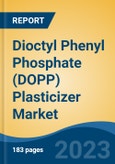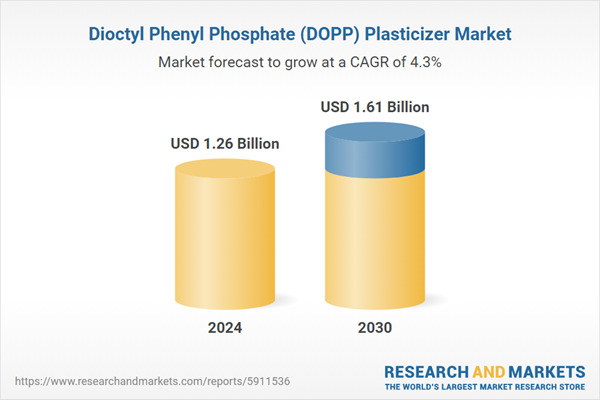Speak directly to the analyst to clarify any post sales queries you may have.
10% Free customizationThis report comes with 10% free customization, enabling you to add data that meets your specific business needs.
DOPP is increasingly favored in green construction practices for its ability to improve the performance of recycled materials, supporting circular economy initiatives. Market players are focusing on R&D to optimize product efficiency and environmental compliance, in response to evolving building standards and regulatory pressures. The versatility and effectiveness of DOPP plasticizers position them as key enablers in modern construction, making the market poised for sustained growth amid global infrastructure development and the growing shift toward sustainable building solutions.
Key Market Drivers
Growing Demand of Dioctyl Phenyl Phosphate (DOPP) Plasticizer from Construction Industry
DOPP plasticizers are widely used in construction due to their ability to enhance material properties such as flexibility, durability, and processing ease. These properties are essential for various applications including concrete, PVC, cables, flooring, and roofing products. Rapid urbanization and significant infrastructure investments are major factors boosting the construction industry. Global construction output is expected to grow from USD 9.7 trillion in 2022 to USD 13.9 trillion by 2037, driven by active markets like China, the United States, and India.DOPP’s compatibility with recycled materials has also aligned it with sustainable construction trends, making it a preferred choice in green building projects. As global infrastructure initiatives increasingly emphasize longevity, efficiency, and environmental impact, the demand for DOPP plasticizers is set to grow in parallel, reinforcing their critical role in construction material formulations.
Key Market Challenges
Volatility in Cost of Raw Materials
Raw materials used in DOPP production, such as phenylphosphonic acid monooctyl ester, are susceptible to price fluctuations influenced by commodity cycles, geopolitical risks, regulatory changes, and supply chain disruptions. Such volatility affects overall production costs and may compel manufacturers to increase product prices, which can hinder adoption, particularly in price-sensitive industries.This cost unpredictability presents a significant barrier to market growth. To mitigate this, manufacturers are exploring alternative sourcing strategies, refining production efficiencies, and enhancing supply chain resilience to sustain competitive pricing and market stability.
Key Market Trends
Growing Demand for Flame Retardant Plastics
The rising need for flame-retardant plastics across various industries is a significant trend supporting DOPP market expansion. DOPP’s flame-retardant properties make it a valuable additive in PVC and other polymer systems, particularly in sectors such as automotive, electronics, and construction, where safety and regulatory compliance are critical.With increasing emphasis on carbon reduction and sustainable materials, the demand for flame-retardant thermoplastics is growing. DOPP aligns well with this trend, offering a balance of performance and environmental compatibility. The broader shift toward sustainability and safety standards is expected to further elevate the role of DOPP in next-generation material development.
Key Players Profiled in this Dioctyl Phenyl Phosphate (DOPP) Plasticizer Market Report
- BASF SE
- Exxon Mobil Corporation
- Eastman Chemical Company
- Evonik Industries AG
- LG Chem Ltd
- Kaneka Corporation
- UPC Technology Corporation
- Nan Ya Plastics Corporation
- DIC Corporation
- ADEKA CORPORATION
Report Scope
In this report, the Global Dioctyl Phenyl Phosphate (DOPP) Plasticizer Market has been segmented into the following categories, in addition to the industry trends which have also been detailed below:Dioctyl Phenyl Phosphate (DOPP) Plasticizer Market, by Grade:
- Premium Grade
- First Grade
- Qualified Grade
Dioctyl Phenyl Phosphate (DOPP) Plasticizer Market, by Application:
- Automotive
- Flexible PVC
- Flooring Surfaces
- Gaskets
- Pressure Sensitive Adhesives
- Others
Dioctyl Phenyl Phosphate (DOPP) Plasticizer Market, by Region:
- North America
- United States
- Canada
- Mexico
- Europe
- France
- United Kingdom
- Italy
- Germany
- Spain
- Asia-Pacific
- China
- India
- Japan
- Australia
- South Korea
- South America
- Brazil
- Argentina
- Colombia
- Middle East & Africa
- South Africa
- Saudi Arabia
- UAE
- Egypt
Competitive Landscape
Company Profiles: Detailed analysis of the major companies present in the Global Dioctyl Phenyl Phosphate (DOPP) Plasticizer Market.Available Customizations
With the given market data, the publisher offers customizations according to a company's specific needs. The following customization options are available for the report.Company Information
- Detailed analysis and profiling of additional market players (up to five).
This product will be delivered within 1-3 business days.
Table of Contents
Companies Mentioned
The leading companies profiled in this Dioctyl Phenyl Phosphate (DOPP) Plasticizer market report include:- BASF SE
- Exxon Mobil Corporation
- Eastman Chemical Company
- Evonik Industries AG
- LG Chem Ltd
- Kaneka Corporation
- UPC Technology Corporation
- Nan Ya Plastics Corporation
- DIC Corporation
- ADEKA CORPORATION
Table Information
| Report Attribute | Details |
|---|---|
| No. of Pages | 185 |
| Published | May 2025 |
| Forecast Period | 2024 - 2030 |
| Estimated Market Value ( USD | $ 1.26 Billion |
| Forecasted Market Value ( USD | $ 1.61 Billion |
| Compound Annual Growth Rate | 4.3% |
| Regions Covered | Global |
| No. of Companies Mentioned | 10 |









